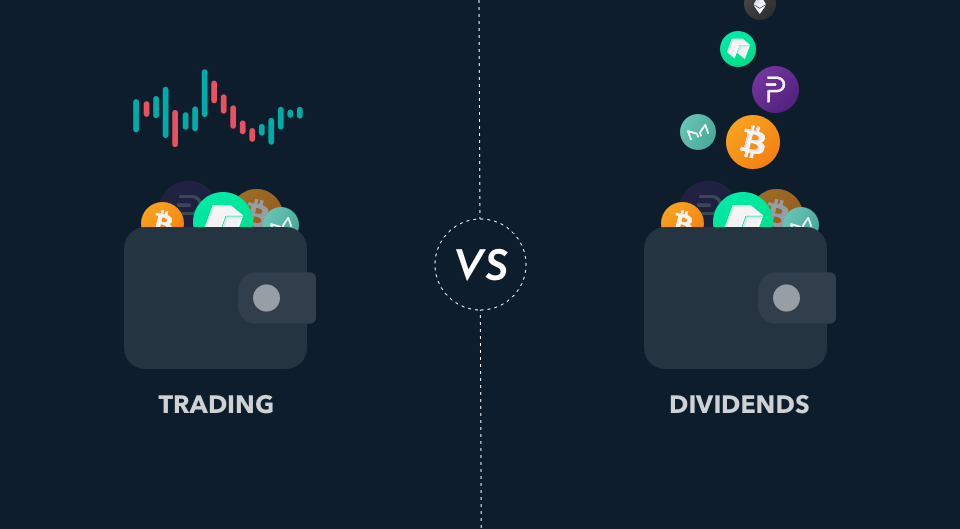Temettüler (İngilizce’de “Divident”) , bir şirketin karının bir kısmının hissedarlarına dağıtılan ödemelerdir. Bu ödemeler, hisse senedi sahiplerine şirketin karından pay vermek amacıyla yapılan dağıtımlardır. Temettüler, şirketin performansına, karlılığına ve yönetim politikalarına bağlı olarak değişebilir.
Geleneksel hisse senedi piyasasında temettüler, hisse senedi sahiplerine genellikle nakit para veya ek hisse senetleri olarak ödenir. Şirketler, genellikle belirli bir tarihte (temettü tarihi) hissedarlarına ne kadar ödeme yapacaklarını açıklarlar. Temettü ödemeleri, genellikle şirketin karını veya gelirini göz önüne alarak hesaplanır.
Temettü alma hakkı, hisse senedi sahiplerinin paylarının üzerinde bir hak olarak bulunur. Bir kişi bir şirketin hisse senedine sahipse, o kişi temettü ödemelerinden yararlanabilir. Ancak temettü miktarı, kişinin sahip olduğu hisse sayısına ve şirketin karına bağlı olarak değişebilir.
Geleneksel hisse senedi piyasasında temettüler, yatırımcılara düzenli gelir kaynağı sağlayabilir ve uzun vadeli yatırımlar için önemli bir unsurdur. Temettü ödemeleri, şirketin karlılığını ve finansal sağlığını yansıttığı için yatırımcılar için önemli bir değer ölçütü olarak kabul edilir.
Kripto Para Temettüleri Nasıl İşler?
Kripto para temettüleri, geleneksel hisse senedi piyasasındaki temettülerle benzerlik gösteren ancak dijital varlıklar olan kripto paralarla ilgili ödemelerdir. Bunlar, belirli bir kripto para varlığına sahip olan kişilere dağıtılan ödemelerdir. Ancak kripto para temettüleri, geleneksel temettülerden birkaç önemli açıdan farklılık gösterir:
- Dijital Varlık Tabanlı: Kripto para temettüleri, genellikle bir projenin veya kripto paranın ekosistemi içindeki katkılara dayalı olarak verilir. Kripto paralar, blockchain teknolojisi üzerine inşa edilmiş dijital varlıklardır ve temettü ödemeleri de bu dijital varlıkların sahiplerine yapılan ödemelerdir. Bu nedenle, geleneksel temettüler gibi fiziksel hisse senetleri veya şirketlerle ilişkilendirilmezler.
- Değişkenlik: Kripto para temettüleri, kripto paranın işleyişine ve projenin politikalarına bağlı olarak değişebilir. Geleneksel temettüler genellikle şirket karlarına dayanırken, kripto para temettüleri daha çeşitli faktörlere dayalı olabilir. Örneğin, bazı kripto paralar, kullanıcıların belirli işlemleri gerçekleştirmesini veya belirli bir süre boyunca varlıklarını tutmasını gerektirebilir.
- Teknolojik Yapı: Kripto para temettüleri, blockchain ve akıllı kontrat teknolojileri kullanılarak otomatik olarak dağıtılabilir. Bu, merkezi olmayan bir şekilde yönetilen ve otomatikleştirilen bir süreç anlamına gelirken, geleneksel temettüler genellikle şirketlerin yönetimi tarafından açıklanır ve dağıtılır.
- Uluslararası Erişim: Kripto para temettüleri, sınırları aşan bir şekilde uluslararası yatırımcılara erişim sağlayabilir. Geleneksel temettüler, genellikle hisse senetlerinin bulunduğu ülkenin finansal düzenlemelerine tabi olabilir ve sınırlı uluslararası erişim sunabilir.
Kripto para temettüleri, kripto varlıklarını uzun vadeli olarak tutan yatırımcılara ek gelir sağlama potansiyeline sahiptir. Ancak bu tür temettüler, kripto paraların volatilitesi ve projelerin başarı durumuna bağlı olarak risk taşıyabilir. Herhangi bir kripto para temettüsünü almadan önce, ilgili projenin politikalarını ve işleyişini anlamak önemlidir.

Kripto Para Temettülerine Hak Kazanmak İçin Yöntemler
Kripto para temettüleri, dijital varlıkların sahiplerine gelir sağlayan bir dizi farklı yol içerebilir. İşte kripto paraların temettü üretebileceği farklı yolların bazıları:
- Staking (Masternode’larda): Birçok kripto para projesi, kullanıcıların varlıklarını belirli bir süre boyunca kilitleyerek (staking) ağın güvenliğine ve işleyişine katkıda bulunmalarına izin verir. Bu katkılar karşılığında staker’lar, blok zinciri ağının işlem ücretleri veya yeni blokların oluşturulması sırasında ödüller olarak kripto para alabilirler. Bu ödüller, staker’ların temettüsü olarak kabul edilir.
- PoS (Proof of Stake) Kâr Paylaşımı: Bazı kripto para projeleri, sahiplerinin sadece belirli bir miktar varlığı kilitlemeleri veya belirli bir rol oynamaları gereken PoS ağlarında çalışır. Bu durumda, PoS ağlarında elde edilen işlem ücretleri ve blok ödülleri, katılımcılar arasında paylaşılır ve sahiplere temettü olarak dağıtılabilir.
- Staking Havuzları: Staking havuzları, bir grup kullanıcının varlıklarını birleştirip daha büyük bir paya sahip olmalarını sağlar. Bu havuzlar, daha küçük yatırımcıların da kripto para temettüsünden yararlanmalarını mümkün kılar. Havuz yöneticileri, staking işlemlerini yönetir ve temettüyü paylaşır.
- Forklardan Kaynaklanan Kripto Temettüleri: Bazı kripto paralar, ağın fork (çatallanma) geçirdiği durumlarda yeni kripto paraların sahiplerine dağıtılmasını içeren temettüler sunabilir. Örneğin, Bitcoin Cash, Bitcoin’in bir fork’uydu ve bu nedenle Bitcoin sahiplerine Bitcoin Cash dağıtıldı.
- DAO (Merkeziyetsiz Otonom Organizasyon) Ödemeleri: Bazı kripto projeleri, kullanıcılar arasında demokratik kararlar alınmasına olanak tanıyan DAO’lar kullanır. DAO’lar, projenin karından veya işlemlerinden elde edilen gelirlerin dağıtılmasını yönlendirebilir ve bu da sahipler için temettü anlamına gelebilir.
Kripto para temettüleri, kullanıcıların varlıklarını uzun vadeli olarak tutmalarını ve projelerin başarısına katkıda bulunmalarını teşvik etmek için kullanılır. Ancak kripto para piyasası, volatilite ve risklerle doludur, bu nedenle temettü kazançları yanı sıra potansiyel kayıpları da içerebilir.
Temettü Veren Kripto Para Örnekleri
Kripto para temettüsü ödemesi yapan bazı kripto paralar şunlar olabilir:
- NEO (NEO): NEO, genellikle “Çin’in Ethereum’u” olarak adlandırılır ve PoS (Proof of Stake) konsensüs mekanizması kullanır. NEO sahipleri, NEO tokenlarını cüzdanlarında tutarak GAS adı verilen bir diğer kripto parayı kazanırlar. GAS, NEO ağında işlem ücretleri ve diğer işlemler için kullanılır.
- VeChain (VET): VeChain, işletmelerin ürünlerini takip etmelerine ve tedarik zincirini optimize etmelerine yardımcı olan bir blockchain platformudur. VET tokenlarını tutan kullanıcılar, VTHO adı verilen bir kripto parayı kazanırlar. VTHO, işlem ücretleri için kullanılır ve sahiplerine dağıtılır.
- KuCoin Shares (KCS): KuCoin Shares, KuCoin adlı bir kripto para borsasına aittir. KCS sahipleri, KuCoin borsasındaki işlemlerden elde edilen gelirin bir kısmını alırlar. Bu, borsa işlem ücretlerinin bir kısmının sahiplere temettü olarak ödenmesi anlamına gelir.
- Tezos (XTZ): Tezos, PoS konsensüs mekanizması kullanır ve XTZ sahipleri, blok üreten ve onaylayanlar olarak ağın güvenliğine katkıda bulundukları için temettü alırlar. Tezos ağındaki işlemlerden elde edilen gelir, XTZ sahiplerine dağıtılır.
- Cosmos (ATOM): Cosmos, farklı blok zincirlerinin birbirleriyle iletişim kurmasını sağlayan bir blockchain ağıdır. ATOM sahipleri, ağın işleyişi için oy kullanarak ve staking yaparak temettü kazanabilirler.

Avantajlar:
- Pasif Gelir: Kripto para temettüleri, sahiplerine pasif bir gelir kaynağı sunar. Varlıklarınızı bir süre boyunca kilitleyerek veya tutarak, düzenli olarak temettü kazanabilirsiniz.
- Uzun Vadeli Yatırım: Kripto para temettüleri, varlıklarınızı uzun vadeli olarak tutmanızı teşvik eder. Bu, piyasa dalgalanmalarından kısa vadeli etkilenmek yerine uzun vadeli büyümeyi hedeflemenizi sağlayabilir.
- Proje Katkısı: Bazı kripto paralar, ağın işleyişine ve güvenliğine katkıda bulunan kullanıcılara ödül verir. Bu, projelerin daha fazla benimsenmesine ve büyümesine katkı sağlar.
- Diversifikasyon: Kripto para temettüleri, klasik temettü ödemeleri gibi farklı bir gelir kaynağı sağlar ve portföyünüzü çeşitlendirmenize yardımcı olabilir.
Dezavantajlar:
- Yüksek Volatilite: Kripto para piyasası son derece volatil olduğundan, temettü kazançları da aynı derecede dalgalanabilir. Değer kaybı yaşanabilir.
- Risk: Kripto para temettüleri yatırımı, kripto paraların risklerini içerir. Projeler başarısız olabilir veya dolandırıcılık vakaları yaşanabilir.
- Değer Kaybı Riski: Kripto para projelerinin değeri hızla düşebilir veya projenin sona ermesi durumunda temettüler kaybedilebilir.
- Karmaşık İşleyiş: Kripto para temettüleri almak, belirli kurallara ve işleyişe tabi olabilir. Bu kuralları anlamak ve takip etmek zor olabilir.
- Yasal ve Vergi Sorunları: Kripto para temettüleri, farklı ülkelerde farklı vergi düzenlemelerine tabi olabilir. Yatırımcılar, vergi yükümlülüklerini anlamak ve yerine getirmek zorundadır.
Sonuç olarak, kripto para temettüleri yatırımı, potansiyel gelir ve risklerle doludur. Yatırım yapmadan önce dikkatli bir araştırma yapmak, projenin arkasındaki ekibi incelemek ve kişisel yatırım hedeflerinizi göz önünde bulundurmak önemlidir. Kripto para temettüleri, bazı yatırımcılar için cazip olabilir, ancak herkes için uygun olmayabilir.






